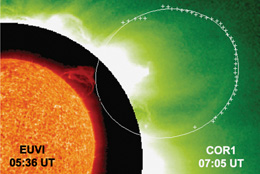Research Abstract
地球の方向を向いたコロナ質量放出の三次元伝搬
Propagation of an Earth-directed coronal mass ejection in three dimensions
2010年9月21日 Nature Communications 1 : 74 doi: 10.1038/ncomms1077

太陽のコロナ質量放出(CME)は地球に有害な宇宙天気をもたらす最も重要な要因であるが、太陽圏におけるその伝搬を支配する物理はよくわかっていない。 NASAのSTEREO(Solar Terrestrial Relations Observatory)探査機によるCMEの立体画像によって、その三次元(3D)伝搬について知見がいくらか得られたが、真の3D構造の再構築が難し いため、CMEの発展を支配する機構はまだ十分に解明されていない。本論文では、新しい楕円tie-pointing法を用いて、完全なCME前面を3D で再構築した。その結果、高い黄緯から黄道に沿って湾曲した軌道を定量化し、増加する角度幅と2 R◎から46 R◎(約0.2 AU)までの伝搬を測定できた。7 R◎を超えると、CMEの運動は太陽風の空力抗力によって決まり、我々の再構築結果を3D磁気流体シミュレーションの入力として用いると、地球近傍のラグランジュ点L1への正確な到達時間を決定できることを、我々は示す。
- ダブリン大学トリニティ・カレッジ(アイルランド)
Solar coronal mass ejections (CMEs) are the most significant drivers of adverse space weather on Earth, but the physics governing their propagation through the heliosphere is not well understood. Although stereoscopic imaging of CMEs with NASA's Solar Terrestrial Relations Observatory (STEREO) has provided some insight into their three-dimensional (3D) propagation, the mechanisms governing their evolution remain unclear because of difficulties in reconstructing their true 3D structure. In this paper, we use a new elliptical tie-pointing technique to reconstruct a full CME front in 3D, enabling us to quantify its deflected trajectory from high latitudes along the ecliptic, and measure its increasing angular width and propagation from 2 to 46 (0.2 AU). Beyond 7 , we show that its motion is determined by an aerodynamic drag in the solar wind and, using our reconstruction as input for a 3D magnetohydrodynamic simulation, we determine an accurate arrival time at the Lagrangian L1 point near Earth.

